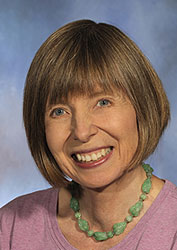Jenny Macfie

Website
Jenny Macfie (deceased)
Professor Emeritus
Key words: Developmental Psychopathology, Opioid Misuse in Pregnancy, Infant Development, Borderline Personality Disorder
Research
Research Interests
Child development, attachment, self development, borderline personality disorder, role reversal
Research Statement
Dr. Jenny Macfie works within a developmental psychopathology framework at the intersection of clinical and developmental psychology. She is interested in the development of adult psychopathology that has strong conceptual links to early childhood development. Specifically she focuses on the developmental tasks of attachment, self development and self-regulation. She is currently studying development in children and adolescents (age 4-6 and 14-17) whose mothers have borderline personality disorder (BPD). Methodology includes adult attachment interviews (AAI), filmed mother-child and mother-adolescent interactions and preschoolers’ story-telling.
Current and Future Directions
We are currently following up the children and adolescents of mothers with BPD and normative comparisons in middle childhood and early adulthood respectively. We continue to be interested in identifying possible precursors to BPD. Studies currently underway include the study of temperament, maltreatment, dissociation, emotional availability, autonomy and relatedness, role reversal, rejection sensitivity and attachment. In the future we plan to study offspring of women with BPD in a longitudinal study from infancy to kindergarten.
See the web page for the Child and Adolescent Development Lab for more details on research projects: http://macfie.utk.edu
Honors
- 2013-present Editorial Board, Personality Disorders: Theory, Research, and Treatment
- 2008-present Editorial Board, Development and Psychopathology
- 2009-10 National Institutes for Health (NIH) Clinical Research Loan Repayment Award, “Child development in children whose mothers have borderline personality disorder.”
- 2009 Society for Research in Child Development Award for top 10 article downloaded from Child Development Perspectives. Development in children and adolescents whose mothers have borderline personality disorder
- 2005-2007 National Institutes for Health (NIH) Clinical Research Loan Repayment Award, “Child development in children whose mothers have borderline personality disorder.”
- 1999-2002 National Institute for Child Health and Human Development (NICHD) Research Service Award
- 1999 Lisa Flanagan Grossman Memorial Award
Grants
- 2006-2008 National Institute for Mental Health (NIMH) R03 MH077841. Principal Investigator. “Identifying risk and psychopathology in children aged 4-6 whose mothers have borderline personality disorder.” $100,000.
- 2004 Professional Development Award, University of Tennessee
- 2005 Scholarly Activities Research Incentive Funding, University of Tennessee
- 2004 Mental Health Development Fund, University of Tennessee
Publications
Macfie, J. & Strimpfel, J. M. (2014). Parenting and the development of borderline personality disorder. In C. Sharp & J. L. Tackett (Eds.), Handbook of borderline personality disorder in children and adolescents (pp. 277-292). New York, NY: Springer.
Macfie, J., Swan, S. A., Fitzpatrick, K. L., Watkins, C. D., & Rivas, E. M. (2014). Mothers with borderline personality disorder and their young children: Adult Attachment Interviews, mother-child interactions and children’s narrative representations, Development and Psychopathology, 26, 539-551.
Watkins*, C. D., & Macfie, J. (2013). Psychodynamic psychotherapy with adjunctive hypnosis for anxiety and smoking cessation. Clinical Case Studies, 12, 348-359.
Abbas*, A. & Macfie, J. (2013). Supportive and insight-oriented psychodynamic psychotherapy for posttraumatic stress disorder in an adult male survivor of sexual assault. Clinical Case Studies, 12, 145-156.
Macfie, J. (2012). Do mothers with borderline personality disorder oscillate in their behavior towards their children? Implications for interventions. Personality Disorders: Theory, Research, and Treatment, 3, 98-100.
*Frankel, M. R., & Macfie, J. (2010). Psychodynamic psychotherapy with adjunctive hypnosis for social and performance anxiety in emerging adulthood. Clinical Case Studies, 9, 294-308.
Macfie, J., & *Swan, S. A. (2009). Representations of the caregiver-child relationship and of the self, and emotion regulation in the narratives of young children whose mothers have borderline personality disorder. Development and Psychopathology, 21, 993-1011.
Macfie, J. (2009). Development in children and adolescents whose mothers have borderline personality disorder. Child Development Perspectives, 3, 66-71.
Macfie, J., Fitzpatrick*, K. L., Rivas*, E. M., & Cox, M. J. (2008). Independent influences on mother-toddler role reversal: Infant-mother attachment disorganization and role reversal in mother’s childhood. Attachment and Human Development, 10, 29-39.
Macfie, J., Houts, R. M., Pressel, A. S. & Cox, M. J. (2008). Pathways from infant exposure to marital conflict to parent-toddler role reversal. Infant Mental Health Journal, 29, 1-23.
Macfie, J., Houts, R. M., McElwain, N. L., & Cox, M. J. (2005). The effect of father-toddler and mother-toddler role reversal on the development of behavior problems in kindergarten. Social Development, 14, 514-531.
Macfie, J., McElwain, N. L., Houts, R. M., & Cox, M. J. (2005). Intergenerational transmission of role reversal between parent and child: Dyadic and family system internal working models. Attachment and Human Development, 7, 51-65.
Macfie, J., Cicchetti, D., & Toth, S. L. (2001). The development of dissociation in maltreated preschool-aged children. Development and Psychopathology, 13, 233-253.
Macfie, J., Cicchetti, D., & Toth, S. L. (2001b). Dissociation in maltreated versus nonmaltreated preschoolers. Child Abuse and Neglect, 25, 1253-1267.
Macfie, J., Toth, S. L., Rogosch, F. A., Robinson, J., Emde, R. N., & Cicchetti, D. (1999). Effect of maltreatment on preschoolers’ narrative representations of responses to relieve distress and of role reversal. Developmental Psychology, 35, 461-465.